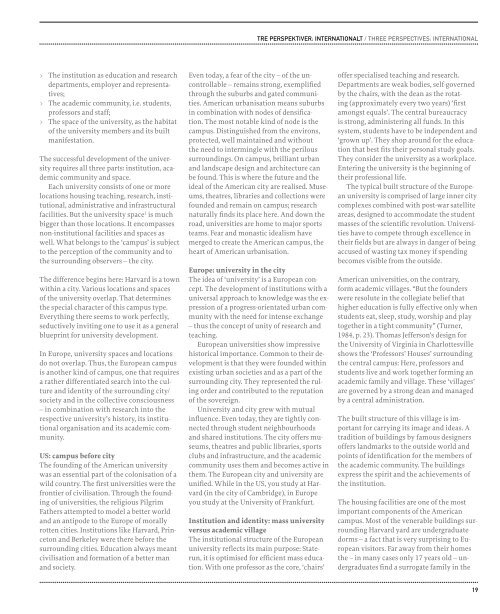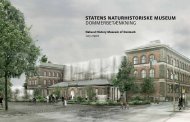Campus og studiemiljø - Bygningsstyrelsen
Campus og studiemiljø - Bygningsstyrelsen
Campus og studiemiljø - Bygningsstyrelsen
Create successful ePaper yourself
Turn your PDF publications into a flip-book with our unique Google optimized e-Paper software.
The institution as education and research<br />
departments, employer and representatives;<br />
> The academic community, i.e. students,<br />
professors and staff;<br />
> The space of the university, as the habitat<br />
of the university members and its built<br />
manifestation.<br />
The successful development of the university<br />
requires all three parts: institution, academic<br />
community and space.<br />
Each university consists of one or more<br />
locations housing teaching, research, institutional,<br />
administrative and infrastructural<br />
facilities. But the university space 1 is much<br />
bigger than those locations. It encompasses<br />
non-institutional facilities and spaces as<br />
well. What belongs to the ‘campus’ is subject<br />
to the perception of the community and to<br />
the surrounding observers – the city.<br />
The difference begins here: Harvard is a town<br />
within a city. Various locations and spaces<br />
of the university overlap. That determines<br />
the special character of this campus type.<br />
Everything there seems to work perfectly,<br />
seductively inviting one to use it as a general<br />
blueprint for university development.<br />
In Europe, university spaces and locations<br />
do not overlap. Thus, the European campus<br />
is another kind of campus, one that requires<br />
a rather differentiated search into the culture<br />
and identity of the surrounding city/<br />
society and in the collective consciousness<br />
– in combination with research into the<br />
respective university’s history, its institutional<br />
organisation and its academic community.<br />
us: campus before city<br />
The founding of the American university<br />
was an essential part of the colonisation of a<br />
wild country. The first universities were the<br />
frontier of civilisation. Through the founding<br />
of universities, the religious Pilgrim<br />
Fathers attempted to model a better world<br />
and an antipode to the Europe of morally<br />
rotten cities. Institutions like Harvard, Princeton<br />
and Berkeley were there before the<br />
surrounding cities. Education always meant<br />
civilisation and formation of a better man<br />
and society.<br />
tre perspektiver: internationalt / tHree perspeCtives: international<br />
Even today, a fear of the city – of the uncontrollable<br />
– remains strong, exemplified<br />
through the suburbs and gated communities.<br />
American urbanisation means suburbs<br />
in combination with nodes of densification.<br />
The most notable kind of node is the<br />
campus. Distinguished from the environs,<br />
protected, well maintained and without<br />
the need to intermingle with the perilous<br />
surroundings. On campus, brilliant urban<br />
and landscape design and architecture can<br />
be found. This is where the future and the<br />
ideal of the American city are realised. Museums,<br />
theatres, libraries and collections were<br />
founded and remain on campus; research<br />
naturally finds its place here. And down the<br />
road, universities are home to major sports<br />
teams. Fear and monastic idealism have<br />
merged to create the American campus, the<br />
heart of American urbanisation.<br />
europe: university in the city<br />
The idea of ‘university’ is a European concept.<br />
The development of institutions with a<br />
universal approach to knowledge was the expression<br />
of a pr<strong>og</strong>ress-orientated urban community<br />
with the need for intense exchange<br />
– thus the concept of unity of research and<br />
teaching.<br />
European universities show impressive<br />
historical importance. Common to their development<br />
is that they were founded within<br />
existing urban societies and as a part of the<br />
surrounding city. They represented the ruling<br />
order and contributed to the reputation<br />
of the sovereign.<br />
University and city grew with mutual<br />
influence. Even today, they are tightly connected<br />
through student neighbourhoods<br />
and shared institutions. The city offers museums,<br />
theatres and public libraries, sports<br />
clubs and infrastructure, and the academic<br />
community uses them and becomes active in<br />
them. The European city and university are<br />
unified. While in the US, you study at Harvard<br />
(in the city of Cambridge), in Europe<br />
you study at the University of Frankfurt.<br />
Institution and identity: mass university<br />
versus academic village<br />
The institutional structure of the European<br />
university reflects its main purpose: Staterun,<br />
it is optimised for efficient mass education.<br />
With one professor as the core, ‘chairs’<br />
offer specialised teaching and research.<br />
Departments are weak bodies, self-governed<br />
by the chairs, with the dean as the rotating<br />
(approximately every two years) ‘first<br />
amongst equals’. The central bureaucracy<br />
is strong, administering all funds. In this<br />
system, students have to be independent and<br />
‘grown up’. They shop around for the education<br />
that best fits their personal study goals.<br />
They consider the university as a workplace.<br />
Entering the university is the beginning of<br />
their professional life.<br />
The typical built structure of the European<br />
university is comprised of large inner city<br />
complexes combined with post-war satellite<br />
areas, designed to accommodate the student<br />
masses of the scientific revolution. Universities<br />
have to compete through excellence in<br />
their fields but are always in danger of being<br />
accused of wasting tax money if spending<br />
becomes visible from the outside.<br />
American universities, on the contrary,<br />
form academic villages. “But the founders<br />
were resolute in the collegiate belief that<br />
higher education is fully effective only when<br />
students eat, sleep, study, worship and play<br />
t<strong>og</strong>ether in a tight community” (Turner,<br />
1984, p. 23). Thomas Jefferson’s design for<br />
the University of Virginia in Charlottesville<br />
shows the ‘Professors’ Houses’ surrounding<br />
the central campus: Here, professors and<br />
students live and work t<strong>og</strong>ether forming an<br />
academic family and village. These ‘villages’<br />
are governed by a strong dean and managed<br />
by a central administration.<br />
The built structure of this village is important<br />
for carrying its image and ideas. A<br />
tradition of buildings by famous designers<br />
offers landmarks to the outside world and<br />
points of identification for the members of<br />
the academic community. The buildings<br />
express the spirit and the achievements of<br />
the institution.<br />
The housing facilities are one of the most<br />
important components of the American<br />
campus. Most of the venerable buildings surrounding<br />
Harvard yard are undergraduate<br />
dorms – a fact that is very surprising to European<br />
visitors. Far away from their homes<br />
the – in many cases only 17 years old – undergraduates<br />
find a surr<strong>og</strong>ate family in the<br />
19

















